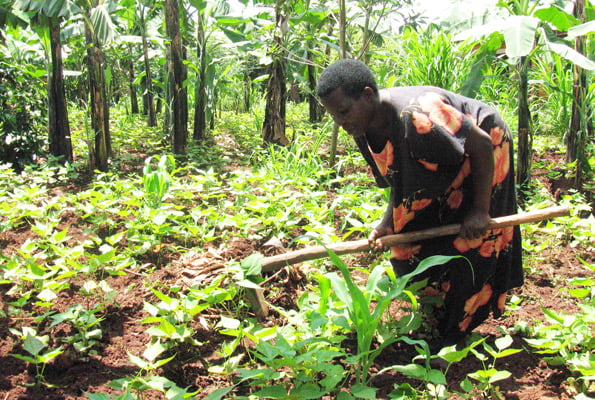Prime
Test soil for better yields, say experts

Ms Jovia Asingwire (left) in her onion garden in Mubende District, on December 14, 2018. Experts have advised farmers to test soils to understand what kind of crops and fertilisers to use to improve yields. PHOTO/FILE
What you need to know:
- The soil nutrient distribution maps show that while phosphorus is lacking in nine districts, it exists in high quantities in Kasese and Bunyangabu districts.
Farmers gearing up for the planting season have been urged to embrace soil testing if they are to boost the productivity of their land to maximise yields. Experts say soil testing is the missing link in achieving agricultural mordernisation.
Late last year, the Ministry of Agriculture, Animal Industry and Fisheries (MAAIF), under its Agricultural Cluster Development Project (ACDP), carried out soil testing on 7,200 farms in 720 sub-counties, in 57 districts, to find out the soil fertility status.
The results and analysis were disseminated last week to chief administrative officers and district agricultural officers from the districts where the project is being implemented.
Dr Henry Nakelet Opolot, the commissioner for agricultural extension and skills management, and the project coordinator, said the soil fertility status can affect food security in the country.
“Soil testing is the key to knowing what micronutrients the soil has or lacks. This knowledge will empower farmers to make a decision on the right type of fertiliser to use to increase their yields. This is the only way we can achieve the correct agronomy,” he said.
The project, which has been running since 2016 and will end in September 2023, is funded by the World Bank to a tune of $150 million (Shs557 billion). The project’s key objective is to increase production and marketable volumes for specifically coffee, rice, maize, beans, and cassava.
Through an e-voucher system, farmers in the participating districts are given inputs such as seeds, fertilisers, mechanisation services, and post-harvest handling materials at a subsidised cost.
Plants need a number of micronutrients to grow, such as, phosphorus, manganese, potassium, and organic matter.
Mr John Ilukor, an agricultural economist with the World Bank, said while phosphorus is essential for plant growth, the soil testing exercise showed it is the most limiting micronutrient in Ugandan soil.
“Nine out of the 57 districts had the right amount of phosphorus. This means the soils in those districts are in dire need of high phosphorus fertilisers. The soil maps also show that the quantities of micronutrients in the soils differ per district,” he says.
The soil nutrient distribution maps show that while phosphorus is lacking in nine districts, it exists in high quantities in Kasese and Bunyangabu districts.
Mr Patrick Kamwezi, the district agricultural officer for Bushenyi, said his district has a low soil pH.
“Our soil pH is 4.7, which is highly acidic. Most farmers in Bushenyi use the NPK fertiliser whose major component is phosphorus. This type of fertiliser cannot be taken up in our acidic soil. If the farmers had known the quality of their soil beforehand, they would have opted for another type of fertiliser,” he said.
Soil PH is the measure of acidity of the soil. Having the correct pH is important for healthy plant growth.
“We should discard the mentality that Uganda’s soils are naturally fertile. This soil analysis is going to create demand for soil testing,” Mr Kamwezi said.
Mr John Sabuni Mwesigye, the senior agricultural officer of Kasese District, asked farmers to accept change.
“There are different fertilisers on the market but each soil type needs a specific fertiliser. After the district officials disseminate the soil analysis to the farmers, they are going to develop fertilisation plans. Otherwise, if a farmer adds a phosphorus-based fertiliser to soils high in phosphorus, they will have worked in vain,” he said.
Soil testing laboratories in Kampala, Gulu, Mubende, Iganga and Mbale districts conducted the soil testing and analysis.
Mr Ilukor said the analysis means there is a need to skill extension workers to test soil on the spot.
Stakeholders are now lobbying for funds for the second phase of the project as phase one comes to an end.





